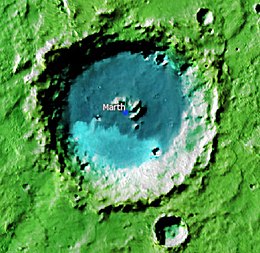
Marth (Martian crater)
Marth Crater is an impact crater on Mars , located in the Oxia Palus quadrangle at 13.0° N and 3.5° W. The crater measures approximately is 98 kilometers in diameter. Its name was approved in 1973, and it was named after Albert Marth . [1] Light and dark markings on the surface are due to dust and sand blown around. Some of the dark sand has formed into dunes.
Page Revisions
| Year | Metadata | Sections | Top Words | First Paragraph |
| 2018 |
76676 characters 2 sections 4 paragraphs 6 images 656 internal links 2 external links |
marth 0.639 gill 0.390 mellit 0.227 danielson 0.183 radau 0.178 mawrth 0.164 confused 0.153 markings 0.153 albert 0.147 sand 0.139 halfway 0.129 blown 0.121 meridian 0.120 oxia 0.112 relation 0.110 |
Marth Crater is an impact crater on Mars , located in the Oxia Palus quadrangle at 13.0° N and 3.5° W. The crater measures approximately is 98 kilometers in diameter. Its name was approved in 1973, and it was named after Albert Marth . [1] Light and dark markings on the surface are due to dust and sand blown around. Some of the dark sand has formed into dunes. |
|
| 2017 |
35306 characters 2 sections 4 paragraphs 9 images 167 internal links 2 external links |
marth 0.639 gill 0.390 mellit 0.227 danielson 0.183 radau 0.178 mawrth 0.164 confused 0.153 markings 0.153 albert 0.147 sand 0.139 halfway 0.129 blown 0.121 meridian 0.120 oxia 0.112 relation 0.110 |
Marth Crater is an impact crater on Mars , located in the Oxia Palus quadrangle at 13.0° N and 3.5° W. The crater measures approximately is 98 kilometers in diameter. Its name was approved in 1973, and it was named after Albert Marth . [1] Light and dark markings on the surface are due to dust and sand blown around. Some of the dark sand has formed into dunes. |
|
| 2015 |
31176 characters 2 sections 2 paragraphs 8 images 156 internal links 1 external links |
marth 0.734 markings 0.265 albert 0.254 sand 0.239 blown 0.209 oxia 0.194 98 0.187 dark 0.180 palus 0.151 dunes 0.131 1973 0.116 approved 0.106 13 0.102 crater 0.087 light 0.086 |
Marth Crater is an impact crater in the Oxia Palus quadrangle on Mars at 13.0° N and 3.5° W. and is 98.4 km in diameter. Its name was approved in 1973, and it was named after Albert Marth . [1] Light and dark markings on the surface are due to dust and sand blown around. Some of the dark sand has formed into dunes. |